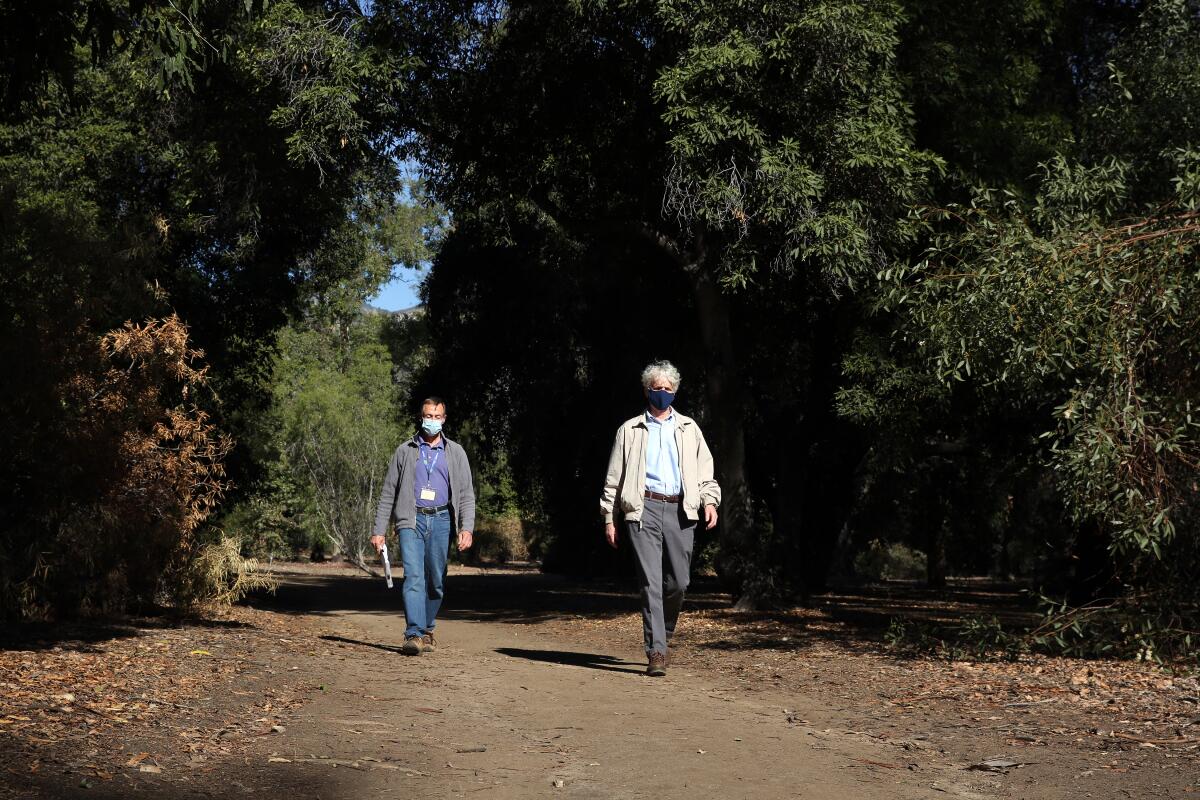Consortium wants to cut down L.A. County Arboretum trees to make room for storm water treatment

- Share via
Officials at the Los Angeles County Arboretum and Botanic Garden are in an uproar over a plan to manage storm water and boost climate resiliency by cutting down “specimen trees” — some 70 years old and more than 100 feet tall — to make room for groundwater recharge ponds and a pump station.
The strategy was crafted by a consortium of five foothill cities and Los Angeles County Public Works. They believe a portion of the 127-acre paradise of flowering trees and shrubs in Arcadia, which draws more than 500,000 visitors each year, is conveniently located to capture, clean and store storm water pumped out of the nearby Arcadia Wash.
Construction of the facility that would consume up to 4 acres of the arboretum’s Australia section could begin within a year or two, according to the group, which comprises the cities of Arcadia, Bradbury, Duarte, Monrovia and Sierra Madre, plus the county.
In the meantime, opponents led by executives of the Los Angeles Arboretum Foundation, a nonprofit founded in 1947 to raise financial support for the botanic garden, are sounding the alarm.
“A project of this scale would require the sacrifice of up to hundreds of irreplaceable arboreal specimens — and we’re not going to let that happen,” Richard Schulhof, chief executive of the foundation, said Friday. “The arboretum is not the right place for it.”
Tom Tompkins, 72, who lives near groves in the area targeted for grading and construction, has joined forces in the campaign to stop what critics say would be the largest physical disturbance of arboretum grounds since it opened to the public in 1956.
“This is a bad thing,” Tompkins said. “In addition to tearing down trees in order to put in an industrial wastewater treatment system, they would drive down the home values of those of us who moved here in the first place to be next to the beautiful arboreal park.”
Other opponents include Donald R. Hodel, an emeritus environmental horticulturist with the University of California Cooperative Extension, who described the proposed project as “a travesty.”
“It is a project that the arboretum does not want,” Hodel said, “and is more or less being forced upon the institution by outside municipalities and agencies.”
Alex Tachiki, an administrator for the city of Monrovia and leader of the Rio Hondo/San Gabriel River Water Quality Group, said such statements are premature.
“I know there are a lot of very passionate folks in the area,” Tachiki said. “But this project is still very early on in its development. The acreage needed and number of trees that may need removal have not been determined yet.”
In any case, he added, “the arboretum is a highly efficient location for this facility.”
The proposal aims to pump storm water into a series of ponds, where it would be filtered naturally through roots and soil before making its way down into aquifers. A small amount of the total storm water captured and cleaned each year would be diverted to the arboretum’s Baldwin Lake.
Los Angeles County Supervisor Kathryn Barger, whose district includes the arboretum, was not available for comment. But Rick Velasquez, Barger’s assistant chief deputy, said she is “keenly aware of the need to balance preservation at the arboretum with the concerns of the local community.”
“Our office is working to bring together all of the stakeholders involved,” he said, “including the arboretum, representatives from the surrounding cities and the county departments of Public Works and [Recreation and Parks].”
Schulhof says the proposal’s supporters miss the point, noting that as many as 425 trees from 29 plant families, 53 genera and 175 species are at stake. Among them are several critically endangered trees, as well as many that were grown from seeds donated over the decades by people including Samuel Ayres, who in 1947 found the site for the botanic garden, at the request of the the Southern California Horticultural Society, at the old Lucky Baldwin Ranch, which was being subdivided for sale.
The arboretum’s grounds and trees have been under the care of skilled horticulturists for decades.
Nodding appreciably toward a native coast live oak with a canopy 30 feet high and 60 feet across, Schulhof said, “Even a magnificent old giant like that one is sensitive to soil disturbance.”
Then there’s the consortium’s web page about the project, which refers to the arboretum’s Australia section as “underutilized.”
“That is absolutely not true,” Schulhof said, “and a cause for concern.”








